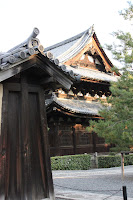Going off the beaten path for udon and tempura in Kyoto

A world’s great cuisine must have a noodle dish. Certainly, the French would realize sooner or later what the Italians, the Chinese and the Japanese have known for centuries. A simple noodle can be sooo satisfying. Of all the different kinds of Japanese noodle, when done right, udon is perhaps my favorite. The right place is usually not going to be in the middle of a touristy area, nor will it need to be expensive. The right place should be a secret, known by locals and guarded from foreigners, unless of course the foreigners have local friends who don’t mind driving them an hour away from the city center into the inner sanctum of the Kyoto suburbs, a place only for those in the know. Right? Wrong! Ok, not exactly. Our friends know a good udon when they see one. Though hardly a proverbial hole-in-the-wall, they've been coming to Hanamaru for years. Since opening in 2001, Hanamaru has become Japan's largest udon franchise chain. The shop is located at the outskirts of Kyoto, as





